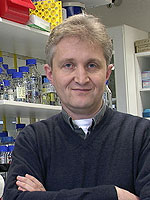|
PhD 1987, University of California, San Diego, Postdoc, The Salk Institute, La Jolla, California
1991 Junior Group Leader, ZMBH,University of Heidelberg
1998 Professor of Molecular Biology, ZMBH
2000 Director, Department of Neurogenetics Max Planck Institute of Experimental Medicine, Göttingen and Adj. Professor of Molecular Biology, Heidelberg
|
|
|
We are interested in the mechanisms of neuron-glia interactions in the higher nervous system,
and in the genes that are required for normal glial cell function. Here, transgenic and mutant
mice have become important to study developmental processes as well as genetic diseases.
For example, oligodendrocytes are glial cells highly specialized for enwrapping CNS axons with
multiple layers of membranes, known to provide electrical insulation for rapid impulse propagation.
We found that oligodendrocytes are also essential for maintaining the long-term integrity of
myelinated axons, independent of the myelin function itself. The mechanisms by which
oligodendrocytes support long-term axonal survival are still under investigation.
The importance of glial cells as the "first line of neuroprotection", however,
is illustrated by several myelin-associated diseases in which axonal neurodegeneration contribute
to progressive disability. These range in humans from peripheral neuropathies (CMT1) to spastic
paraplegia (SPG2), and presumably multiple sclerosis (MS) and certain forms of psychiatric
disorders. We are developing transgenic animal models for some of these diseases, in order to
dissect the underlying disease mechanisms and, in the case of CMT1A, have used these models to
design novel therapeutic strategies.
The glial "decision" to myelinate an axonal segment is partly controlled by the axon itself,
but the signaling mechanism is not understood. We have found that axonal neuregulin-1 (NRG1) is the
major determinant of myelination in the peripheral nervous system. We are now investigating NRG1
dysregulation also in CNS myelination, using quantifiable behavioural functions in mice.
By combining genetics with enviromental risk factors for schizophrenia (in collaboration with
H. Ehrenreich) we will explore the hypothesis that NRG1, a known human schizophrenia susceptibility
gene, points to an important role of myelinating glia in some psychiatric disorders.
Future Projects and Goals
Mechanisms of neuron-glia signalling; function of myelin proteins and lipids; transcriptional
profiling of single cells in vivo; novel mouse models of neuropsychiatric disorders.
|
|
Address:
MPI of Experimental
Medicine
Hermann-Rein-
Strasse 3
37075 Göttingen
Germany
phone:+49-551-38 99 754
fax:+49-551-38 99 758
e-mail: 
Further Information:
http://nave.em.mpg.de
|
|
Lappe-Siefke C, Goebbels S, Gravel M, Nicksch E, Lee J, Braun PE, Griffiths IR,
Nave KA (2003) Disruption of the Cnp1 gene uncouples oligodendroglial functions in axonal support
and myelination. Nature Genet 33:366-374
Michailov G, Sereda V, MW, Brinkmann B, Fischer, TM, Haug B, Birchmeier C, Role L, Lai C, Schwab MH,
Nave KA (2004) Axonal neuregulin-1 regulates myelin sheath thickness. Science 304:700-703.
Saher G, Brugger B, Lappe-Siefke C, Mobius W, Tozawa R. Wehr MC, Wieland F, Ishibashi S,Nave KA
(2005) High cholesterol level is essential for myelin membrane growth. Nature Neurosci 8:468-475
Kassmann CM, Lappe-Siefke C, Baes M, Brügger B, Mildner A, Werner HB, Natt O, Michaelis Th,
Prinz M, Frahm J, Nave KA (2007) Axonal loss and neuroinflammation caused by peroxisome-deficient
oligodendrocytes. Nature Genet 39:969-976
Nave KA, Trapp BD (2008) Axon-glial signaling and the glial support of axon function.
Annu Rev Neurosci 31:535-561.
Brinkmann BG, Agarwal A, Sereda MW, Garratt AN, Müller T, Wende H, Stassart RM, Nawaz S,
Humml C, Velanac V, Radyuschkin K, Goebbels S, Fischer TM, Franklin RJ, Lai C, Ehrenreich H,
Birchmeier C, Schwab MH, Nave KA (2008) Neuregulin-1/ErbB signaling serves distinct functions
in myelination of the peripheral and central nervous system. Neuron 59:581-595
Saher G, Quintes S, Möbius M, Wehr MC, Krämer-Albers EM, Brügger B,Nave KA (2009)
Cholesterol regulates the ER exit of the major adhesion protein P0 in peripheral myelination.
J Neurosci 29:6094-6104
|
|
|
